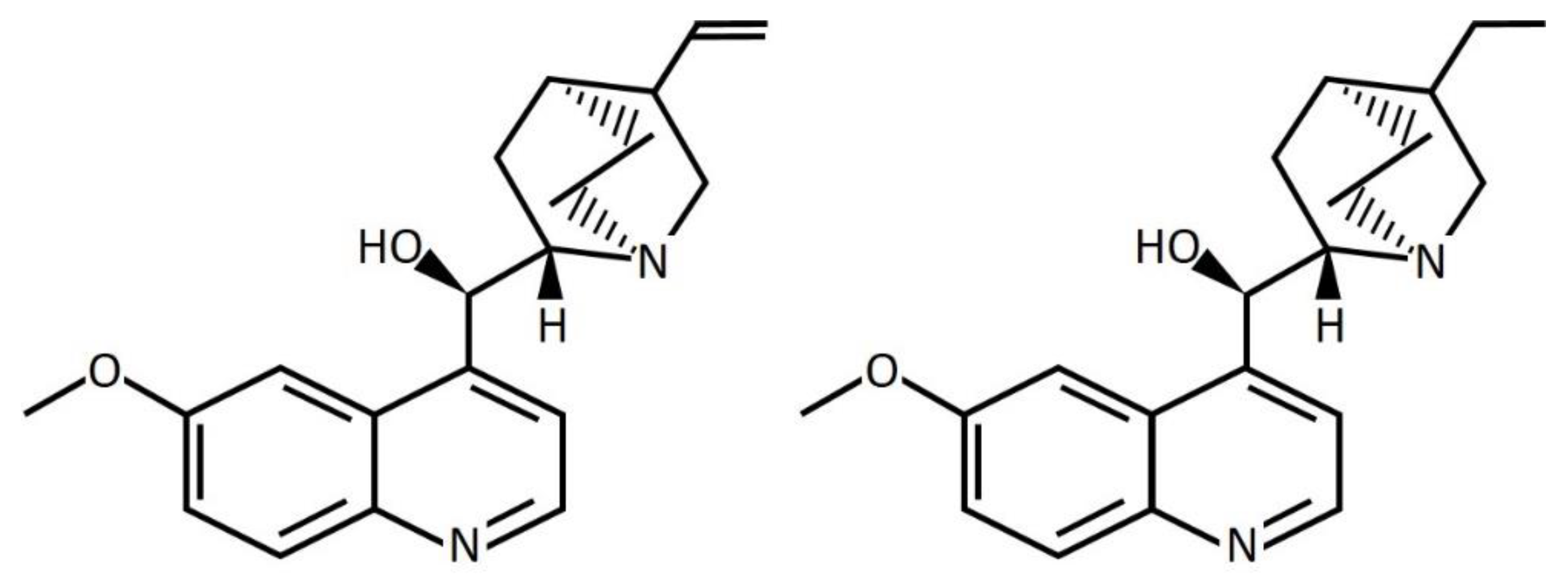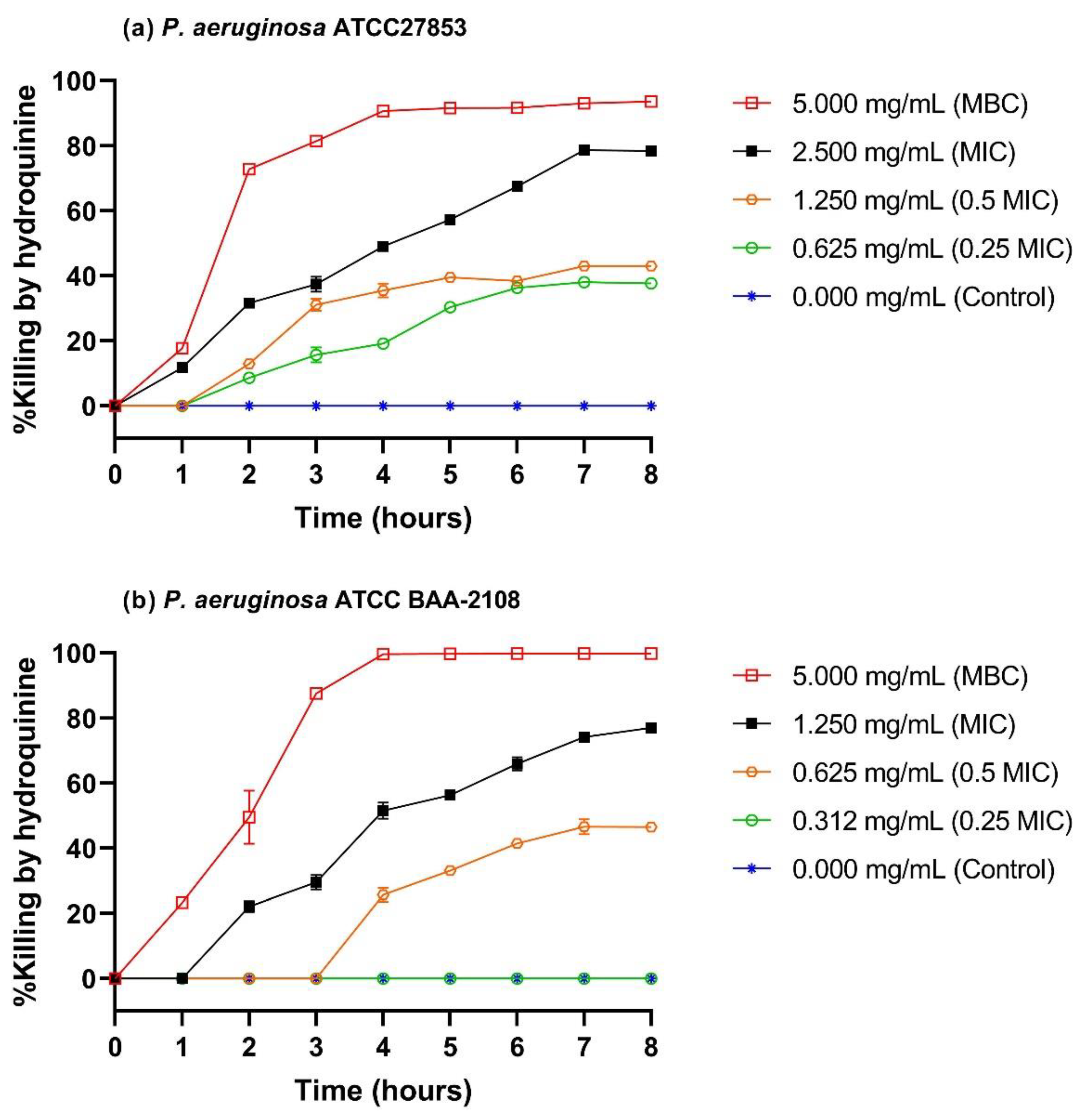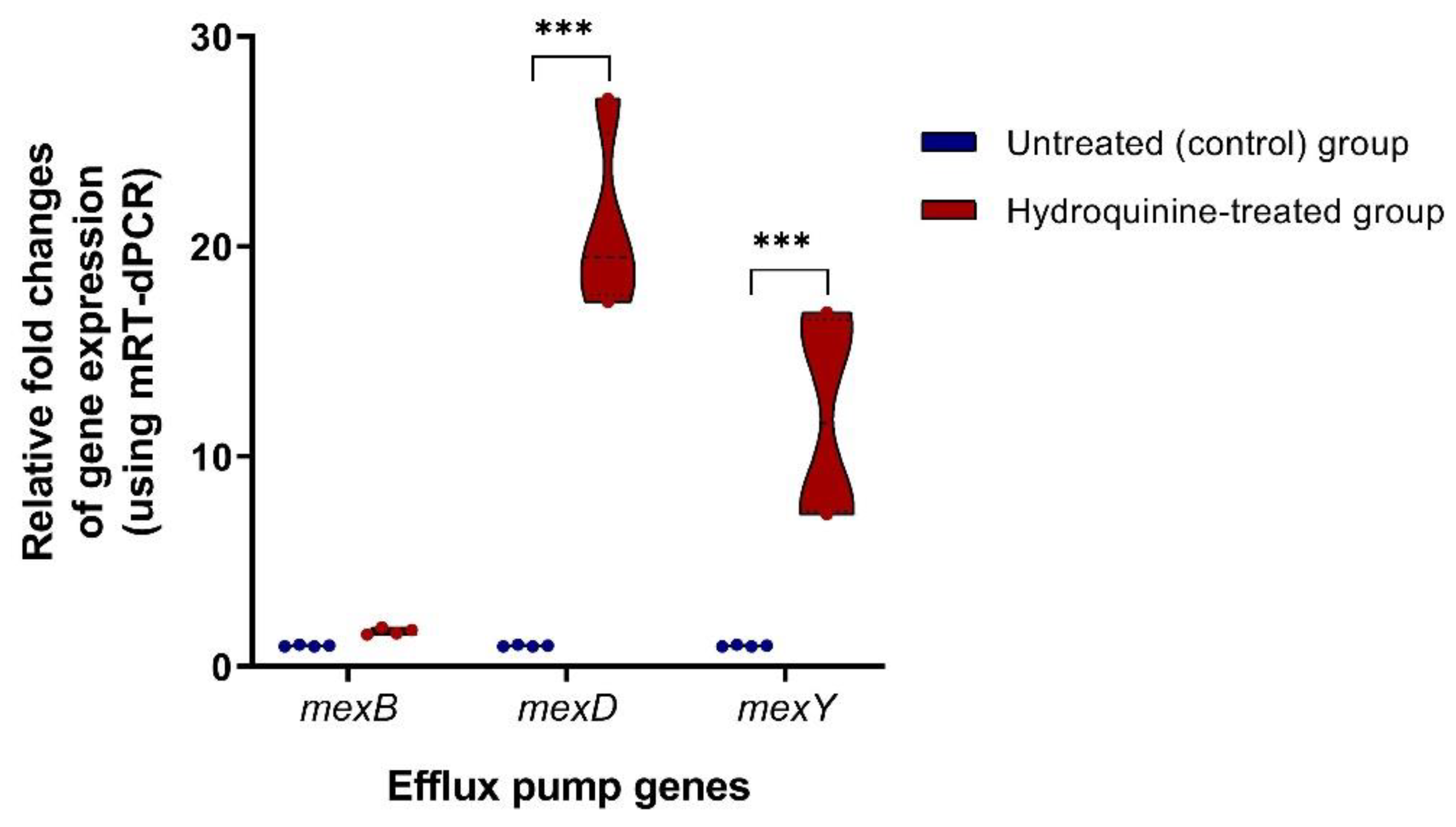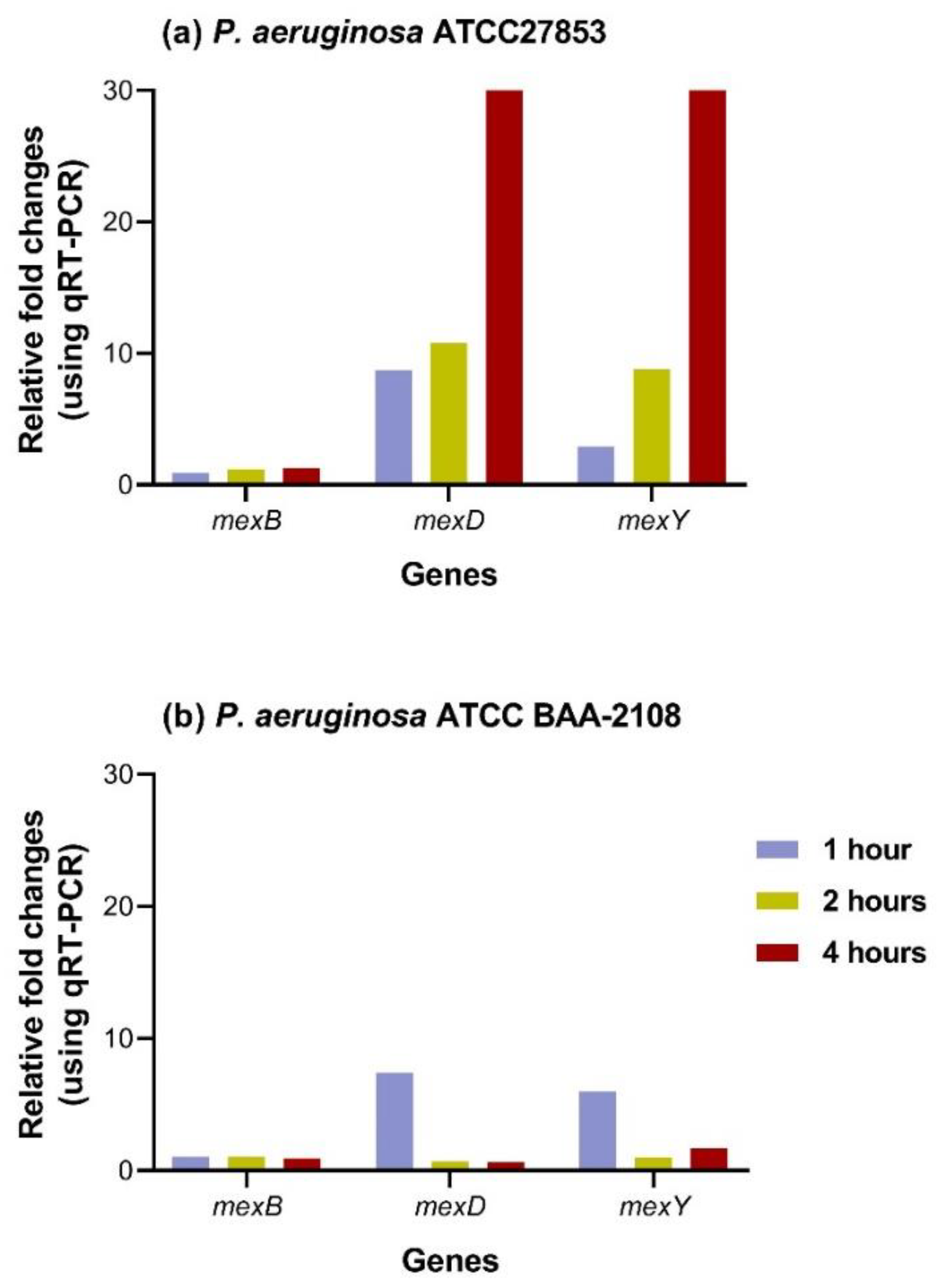Hydroquinine Possesses Antibacterial Activity, and at Half the MIC, Induces the Overexpression of RND-Type Efflux Pumps Using Multiplex Digital PCR in Pseudomonas aeruginosa
Abstract
1. Introduction
2. Materials and Methods
2.1. Preparation of Hydroquinine Solution
2.2. Bacterial Strains, Culture Conditions, and Inoculum Preparation
2.3. Minimum Inhibitory Concentrations (MICs) and Minimum Bactericidal Concentrations (MBCs) of Hydroquinine
2.4. Time-Kill Curve of Hydroquinine
2.5. RNA Extraction and cDNA Synthesis
2.6. RNA Sequencing and Transcriptomic Analysis
2.7. Genomic DNA Extraction
2.8. Detection of RND-Type Efflux Pump Genes Using Multiplex Digital PCR (mdPCR)
2.9. Gene Expression Using Multiplex Reverse Transcription Digital PCR (mRT-dPCR)
2.10. Gene Expression Using Quantitative Reverse Transcription PCR (RT-qPCR)
2.11. Statistical Analysis
3. Results
3.1. Hydroquinine Showed MIC and MBC Values against the Bacteria Tested
3.2. Time-Kill Curve of Hydroquinine against Both P. aeruginosa Strains
3.3. Transcriptomic Analysis of P. aeruginosa ATCC27853 in the Stress Condition of Hydroquinine
3.4. All mexB, mexD, and mexY Genes Were Detected in Both P. aeruginosa Genomes Using mdPCR
3.5. Hydroquinine Induces the mRNA Levels of mexD and mexY in Both P. aeruginosa Strains
4. Discussion
5. Conclusions
Author Contributions
Funding
Institutional Review Board Statement
Informed Consent Statement
Data Availability Statement
Acknowledgments
Conflicts of Interest
References
- Van Duin, D.; Paterson, D.L. Multidrug-resistant bacteria in the community: Trends and lessons learned. Infect. Dis. Clin. N. Am. 2016, 30, 377–390. [Google Scholar] [CrossRef] [PubMed]
- Breidenstein, E.B.; de la Fuente-Núñez, C.; Hancock, R.E. Pseudomonas aeruginosa: All roads lead to resistance. Trends Microbiol. 2011, 19, 419–426. [Google Scholar] [CrossRef] [PubMed]
- Ali, N.M.; Rehman, S.; Mazhar, S.A.; Liaqat, I.; Mazhar, B. Psuedomonas aeruginosa-associated acute and chronic pulmonary infections. In Pathogenic Bacteria; Kırmusaoğlu, S., Bhardwaj, S., Eds.; IntechOpen: London, UK, 2020; pp. 1–21. [Google Scholar]
- Aliaga, L.; Mediavilla, J.D.; Cobo, F. A clinical index predicting mortality with Pseudomonas aeruginosa bacteraemia. J. Med. Microbiol. 2002, 51, 615–701. [Google Scholar] [CrossRef] [PubMed][Green Version]
- Alp, E.; Güven, M.; Yıldız, O.; Aygen, B.; Voss, A.; Doganay, M. Incidence, risk factors and mortality of nosocomial pneumonia in Intensive Care Units: A prospective study. Ann. Clin. Microbiol. Antimicrob. 2004, 3, 17. [Google Scholar] [CrossRef] [PubMed]
- Peña, C.; Cabot, G.; Gómez-Zorrilla, S.; Zamorano, L.; Ocampo-Sosa, A.; Murillas, J.; Almirante, B.; Pomar, V.; Aguilar, M.; Granados, A.; et al. Influence of virulence genotype and resistance profile in the mortality of Pseudomonas aeruginosa bloodstream infections. Clin. Infect. Dis. 2015, 60, 539–548. [Google Scholar] [CrossRef] [PubMed]
- Sader, H.S.; Castanheira, M.; Duncan, L.R.; Flamm, R.K. Antimicrobial susceptibility of Enterobacteriaceae and Pseudomonas aeruginosa isolates from United States Medical Centers stratified by infection type: Results from the International Network for Optimal Resistance Monitoring (INFORM) surveillance program, 2015–2016. Diagn. Microbiol. Infect. Dis. 2018, 92, 69–74. [Google Scholar] [CrossRef]
- Walkty, A.; Lagace-Wiens, P.; Adam, H.; Baxter, M.; Karlowsky, J.; Mulvey, M.R.; McCracken, M.; Zhanel, G.G. Antimicrobial susceptibility of 2906 Pseudomonas aeruginosa clinical isolates obtained from patients in Canadian hospitals over a period of 8 years: Results of the Canadian Ward surveillance study (CANWARD), 2008–2015. Diagn. Microbiol. Infect. Dis. 2017, 87, 60–63. [Google Scholar] [CrossRef]
- Lister, P.D.; Wolter, D.J.; Hanson, N.D. Antibacterial-resistant Pseudomonas aeruginosa: Clinical impact and complex regulation of chromosomally encoded resistance mechanisms. Clin. Microbiol. Rev. 2009, 22, 582–610. [Google Scholar] [CrossRef] [PubMed]
- Nikaido, H.; Pagès, J.M. Broad-specificity efflux pumps and their role in multidrug resistance of Gram-negative bacteria. FEMS Microbiol. Rev. 2012, 36, 340–363. [Google Scholar] [CrossRef] [PubMed]
- Nikaido, H. Antibiotic resistance caused by gram-negative multidrug efflux pumps. Clin. Infect. Dis. 1998, 27 (Suppl. 1), S32–S41. [Google Scholar] [CrossRef] [PubMed]
- Poole, K. Efflux-mediated multiresistance in Gram-negative bacteria. Clin. Microbiol. Infect. 2004, 10, 12–26. [Google Scholar] [CrossRef] [PubMed]
- Fernando, D.M.; Kumar, A. Resistance-nodulation-division multidrug efflux pumps in gram-negative bacteria: Role in virulence. Antibiotics 2013, 2, 163–181. [Google Scholar] [CrossRef] [PubMed]
- Venter, H.; Mowla, R.; Ohene-Agyei, T.; Ma, S. RND-type drug efflux pumps from gram-negative bacteria: Molecular mechanism and inhibition. Front. Microbiol. 2015, 6, 377. [Google Scholar] [CrossRef] [PubMed]
- De Kievit, T.R.; Parkins, M.D.; Gillis, R.J.; Srikumar, R.; Ceri, H.; Poole, K.; Iglewski, B.H.; Storey, D.G. Multidrug efflux pumps: Expression patterns and contribution to antibiotic resistance in Pseudomonas aeruginosa biofilms. Antimicrob. Agents Chemother. 2001, 45, 1761–1770. [Google Scholar] [CrossRef] [PubMed]
- Masuda, N.; Sakagawa, E.; Ohya, S.; Gotoh, N.; Tsujimoto, H.; Nishino, T. Substrate specificities of MexAB-OprM, MexCD-OprJ, and MexXY-oprM efflux pumps in Pseudomonas aeruginosa. Antimicrob. Agents Chemother. 2000, 44, 3322–3327. [Google Scholar] [CrossRef]
- Dreier, J.; Ruggerone, P. Interaction of antibacterial compounds with RND efflux pumps in Pseudomonas aeruginosa. Front. Microbiol. 2015, 6, 660. [Google Scholar] [CrossRef] [PubMed]
- Keith, P. Stress responses as determinants of antimicrobial resistance in Pseudomonas aeruginosa: Multidrug efflux and more. Can. J. Microbiol. 2014, 60, 783–791. [Google Scholar] [CrossRef]
- Tetard, A.; Zedet, A.; Girard, C.; Plésiat, P.; Llanes, C. Cinnamaldehyde induces expression of efflux pumps and multidrug resistance in Pseudomonas aeruginosa. Antimicrob. Agents Chemother. 2019, 63, e01081-01019. [Google Scholar] [CrossRef] [PubMed]
- Fraud, S.; Campigotto, A.J.; Chen, Z.; Poole, K. MexCD-OprJ multidrug efflux system of Pseudomonas aeruginosa: Involvement in chlorhexidine resistance and induction by membrane-damaging agents dependent upon the AlgU stress response sigma factor. Antimicrob. Agents Chemother. 2008, 52, 4478–4482. [Google Scholar] [CrossRef] [PubMed]
- Hou, A.M.; Yang, D.; Miao, J.; Shi, D.Y.; Yin, J.; Yang, Z.W.; Shen, Z.Q.; Wang, H.R.; Qiu, Z.G.; Liu, W.L.; et al. Chlorine injury enhances antibiotic resistance in Pseudomonas aeruginosa through over expression of drug efflux pumps. Water Res. 2019, 156, 366–371. [Google Scholar] [CrossRef] [PubMed]
- Murauer, A.; Ganzera, M. Quantitative determination of major alkaloids in Cinchona bark by supercritical fluid chromatography. J. Chromatogr. A 2018, 1554, 117–122. [Google Scholar] [CrossRef]
- Nontprasert, A.; Pukrittayakamee, S.; Kyle, D.E.; Vanijanonta, S.; White, N.J. Antimalarial activity and interactions between quinine, dihydroquinine and 3-hydroxyquinine against Plasmodium falciparum in vitro. Trans. R. Soc. Trop. Med. Hyg. 1996, 90, 553–555. [Google Scholar] [CrossRef]
- Polet, H.; Barr, C.F. Chloroquine and dihydroquinine. In vitro studies by their antimalarial effect upon Plasmodium knowlesi. J. Pharmacol. Exp. Ther. 1968, 164, 380–386. [Google Scholar]
- Brossi, A.; Uskoković, M.; Gutzwiller, J.; Krettli, A.U.; Brener, Z. Antimalarial activity of natural, racemic and unnatural dihydroquinine, dihydroquinidine and their various racemic analogs in mice infected with Plasmodium Berghei. Exp. 1971, 27, 1100–1101. [Google Scholar] [CrossRef]
- Huffman, A.M.; Ayariga, J.A.; Napier, A.; Robertson, B.K.; Abugri, D.A. Inhibition of Toxoplasma gondii growth by dihydroquinine and its mechanisms of action. Front. Cell. Infect. Microbiol. 2022, 12, 852889. [Google Scholar] [CrossRef]
- Jongjitvimol, T.; Kraikongjit, S.; Paensuwan, P.; Jongjitwimol, J. In vitro biological profiles and chemical contents of ethanolic nest entrance extracts of Thai stingless bees Tetrigona apicalis. Online J. Biol. Sci. 2020, 20, 157–165. [Google Scholar] [CrossRef]
- Kraikongjit, S.; Jongjitvimol, T.; Mianjinda, N.; Sirithep, N.; Kaewbor, T.; Jumroon, N.; Jongjitwimol, J. Antibacterial effect of plant resin collected from Tetrigona apicalis (Smith, 1857) in Thung Salaeng Luang national park, Phitsanulok. Walailak J. Sci. Technol. 2017, 15, 599–607. [Google Scholar] [CrossRef]
- Wolf, R.; Baroni, A.; Greco, R.; Donnarumma, G.; Ruocco, E.; Tufano, M.A.; Ruocco, V. Quinine sulfate and bacterial invasion. Ann. Clin. Microbiol. Antimicrob. 2002, 1, 5. [Google Scholar] [CrossRef]
- Wolf, R.; Tufano, M.A.; Ruocco, V.; Grimaldi, E.; Ruocco, E.; Donnarumma, G.; Baroni, A. Quinine sulfate inhibits invasion of some bacterial skin pathogens. Int. J. Dermatol. 2006, 45, 661–663. [Google Scholar] [CrossRef]
- CLSI. Methods for dilution antimicrobial susceptibility tests for bacteria that grow aerobically. In CLSI document M07-A9; Approved Standard—9th ed.; Clinical and Laboratory Standards Institute: Wayne, PA, USA, 2012. [Google Scholar]
- CLSI. Performance Standards for antimicrobial susceptibility testing. In CLSI Supplement M100, 32nd ed.; Clinical and Laboratory Standards Institute: Wayne, PA, USA, 2022. [Google Scholar]
- Leber, A.L. Minimum bactericidal concentration testing. In Clinical Microbiology Procedures Handbook; John Wiley & Sons: Hoboken, NJ, USA, 2016; pp. 5.14.11.11–15.14.13.16. [Google Scholar]
- Kharal, S.A.; Hussain, Q.; Ali, S.; Fakhuruddin. Quinine is bactericidal. J. Pak. Med. Assoc. 2009, 59, 208–212. [Google Scholar]
- Antika, L.D.; Triana, D.; Ernawati, T. Antimicrobial activity of quinine derivatives against human pathogenic bacteria. IOP Conf. Ser. Earth Environ. Sci. 2020, 462, 012006. [Google Scholar] [CrossRef]
- National Center for Biotechnology Information. PubChem Compound Summary for CID 10651. Hydroquinine. Available online: https://pubchem.ncbi.nlm.nih.gov/compound/Hydroquinine#section=Safety-and-Hazards (accessed on 23 July 2022).
- Abed, F.; Baniya, R.; Bachuwa, G. Quinine-induced disseminated intravascular coagulation. Case Rep. Med. 2016, 2016, 9136825. [Google Scholar] [CrossRef] [PubMed]
- Leanse, L.G.; Dong, P.T.; Goh, X.S.; Lu, M.; Cheng, J.X.; Hooper, D.C.; Dai, T. Quinine enhances photo-inactivation of gram-negative bacteria. J. Infect. Dis. 2020, 221, 618–626. [Google Scholar] [CrossRef]
- Peng, L.; Kang, S.; Yin, Z.; Jia, R.; Song, X.; Li, L.; Li, Z.; Zou, Y.; Liang, X.; Li, L.; et al. Antibacterial activity and mechanism of berberine against Streptococcus agalactiae. Int. J. Clin. Exp. Pathol. 2015, 8, 5217–5223. [Google Scholar] [PubMed]
- NicAogáin, K.; O’Byrne, C.P. The role of stress and stress adaptations in determining the fate of the bacterial pathogen Listeria monocytogenes in the food chain. Front. Microbiol. 2016, 7, 1865. [Google Scholar] [CrossRef]
- Piddock, L.J. Multidrug-resistance efflux pumps—Not just for resistance. Nat. Rev. Microbiol. 2006, 4, 629–636. [Google Scholar] [CrossRef]
- Hancock, R.E.W. The bacterial outer membrane as a drug barrier. Trends Microbiol. 1997, 5, 37–42. [Google Scholar] [CrossRef]
- Morita, Y.; Tomida, J.; Kawamura, Y. MexXY multidrug efflux system of Pseudomonas aeruginosa. Front. Microbiol. 2012, 3, 408. [Google Scholar] [CrossRef]




| Name | Oligonucleotide Sequences (5′ to 3′) | References |
|---|---|---|
| Primers | ||
| MexB F | GATAGGCCCATTTTCGCGTGG | This study |
| MexB R | CGATCCCGTTCATCTGCTGC | This study |
| MexD F | TCATCAAGCGGCCGAACTTC | This study |
| MexD R | GGTGGCGGTGATGGTGATCTG | This study |
| MexY F | CGCAACTGACCCGCTACAAC | This study |
| MexY R | CGGACAGGCGTTCTTCGAAG | This study |
| 16s rRNA F | CATGGCTCAGATTGAACGCTG | This study |
| 16s rRNA R | GCTAATCCGACCTAGGCTCATC | This study |
| Probes | ||
| MexB | (FAM) CGCCTTGGTGATCATGCTCGCG (BHQ1) | This study |
| MexD | (HEX) CTGGCCGGCCTGCTGGTCATTTC (BHQ1) | This study |
| MexY | (Texas Red) CGAAGCCATGCAGGCGATGGAGG (BHQ2) | This study |
| 16s rRNA | (Cy5) CGAGCGGATGAAGGGAGCTTGCTC (BHQ2) | This study |
| Microorganisms | MICs of Hydroquinine (µg/mL) | MBCs of Hydroquinine (µg/mL) | Vehicle Control 1 (%v/v) | MICs of CIP 2 (µg/mL) |
|---|---|---|---|---|
| Gram positive bacteria | ||||
| S. aureus ATCC25923 | 1250 | 1250 | >25% | ND |
| S. aureus ATCC29213 | 1250 | 2500 | >25% | 0.5 (0.12–0.50) |
| Gram negative bacteria | ||||
| E. cloacae ATCC2341 | 1250 | 2500 | >25% | ND |
| E. coli ATCC2452 | 1250 | 1250 | >25% | ND |
| E. coli ATCC25922 | 625 | 1250 | >25% | 0.008 (0.004–0.016) |
| K. pneumoniae ATCC1705 | 1250 | 2500 | >25% | ND |
| P. aeruginosa ATCC BAA-2108 | 1250 | 5000 | >25% | ND |
| P. aeruginosa ATCC27853 | 2500 | 5000 | >25% | 0.5 (0.12–1.00) |
| Gene ID | Gene Name | Gene Description | Log2 FC 1 | FDR 2 | p-Value |
|---|---|---|---|---|---|
| NP_253289 | mexC | Resistance-Nodulation-Cell Division (RND) multidrug efflux membrane fusion protein MexC precursor | 9.47 | 2.56 × 10−19 | 4.79 × 10−23 |
| NP_253288 | mexD | Resistance-Nodulation-Cell Division (RND) multidrug efflux transporter MexD | 6.27 | 3.83 × 10−11 | 3.59 × 10−14 |
| NP_253287 | oprJ | Multidrug efflux outer membrane protein OprJ precursor | 6.02 | 2.90 × 10−10 | 3.80 × 10−13 |
| NP_250709 | mexX | Resistance-Nodulation-Cell Division (RND) multidrug efflux membrane fusion protein MexX precursor | 5.26 | 2.47 × 10−8 | 5.55 × 10−11 |
| NP_250708 | mexY | Resistance-Nodulation-Cell Division (RND) multidrug efflux transporter MexY | 4.90 | 9.60 × 10−8 | 2.88 × 10−11 |
| Microorganisms/Sample | Positive Partitions (%) | Interpretation | ||
|---|---|---|---|---|
| mexB | mexD | mexY | ||
| S. aureus ATCC25923 | 0.0 | 0.0 | 0.0 | Genes absent |
| S. aureus ATCC29213 | 0.0 | 0.0 | 0.0 | Genes absent |
| E. cloacae ATCC2341 | 0.0 | 0.0 | 0.0 | Genes absent |
| E. coli ATCC2452 | 0.0 | 0.0 | 0.0 | Genes absent |
| E. coli ATCC25922 | 0.0 | 0.0 | 0.0 | Genes absent |
| K. pneumoniae ATCC1705 | 0.0 | 0.0 | 0.0 | Genes absent |
| P. aeruginosa ATCC BAA-2108 | 42.1 | 92.9 | 65.0 | Genes present |
| P. aeruginosa ATCC27853 | 87.8 | 83.2 | 43.2 | Genes present |
| Non-template control (NTC) | 0.0 | 0.0 | 0.0 | Genes absent |
Publisher’s Note: MDPI stays neutral with regard to jurisdictional claims in published maps and institutional affiliations. |
© 2022 by the authors. Licensee MDPI, Basel, Switzerland. This article is an open access article distributed under the terms and conditions of the Creative Commons Attribution (CC BY) license (https://creativecommons.org/licenses/by/4.0/).
Share and Cite
Rattanachak, N.; Weawsiangsang, S.; Jongjitvimol, T.; Baldock, R.A.; Jongjitwimol, J. Hydroquinine Possesses Antibacterial Activity, and at Half the MIC, Induces the Overexpression of RND-Type Efflux Pumps Using Multiplex Digital PCR in Pseudomonas aeruginosa. Trop. Med. Infect. Dis. 2022, 7, 156. https://doi.org/10.3390/tropicalmed7080156
Rattanachak N, Weawsiangsang S, Jongjitvimol T, Baldock RA, Jongjitwimol J. Hydroquinine Possesses Antibacterial Activity, and at Half the MIC, Induces the Overexpression of RND-Type Efflux Pumps Using Multiplex Digital PCR in Pseudomonas aeruginosa. Tropical Medicine and Infectious Disease. 2022; 7(8):156. https://doi.org/10.3390/tropicalmed7080156
Chicago/Turabian StyleRattanachak, Nontaporn, Sattaporn Weawsiangsang, Touchkanin Jongjitvimol, Robert A Baldock, and Jirapas Jongjitwimol. 2022. "Hydroquinine Possesses Antibacterial Activity, and at Half the MIC, Induces the Overexpression of RND-Type Efflux Pumps Using Multiplex Digital PCR in Pseudomonas aeruginosa" Tropical Medicine and Infectious Disease 7, no. 8: 156. https://doi.org/10.3390/tropicalmed7080156
APA StyleRattanachak, N., Weawsiangsang, S., Jongjitvimol, T., Baldock, R. A., & Jongjitwimol, J. (2022). Hydroquinine Possesses Antibacterial Activity, and at Half the MIC, Induces the Overexpression of RND-Type Efflux Pumps Using Multiplex Digital PCR in Pseudomonas aeruginosa. Tropical Medicine and Infectious Disease, 7(8), 156. https://doi.org/10.3390/tropicalmed7080156






